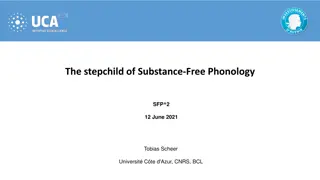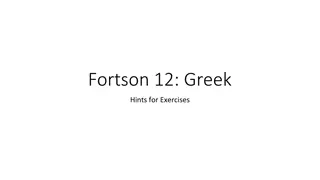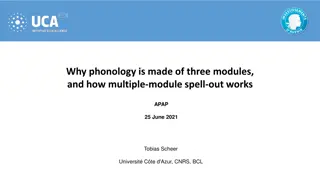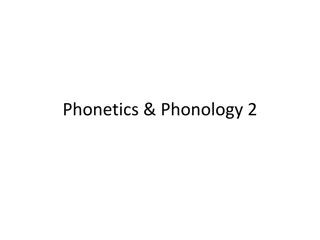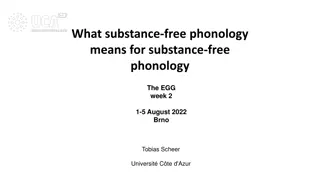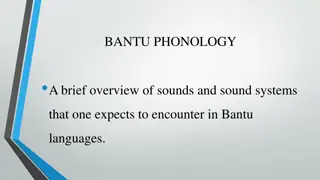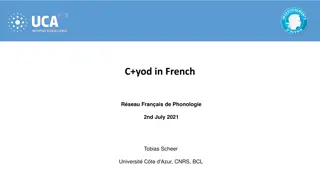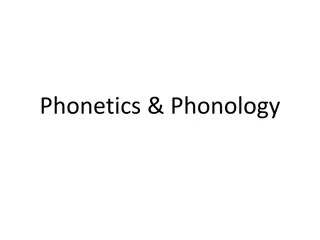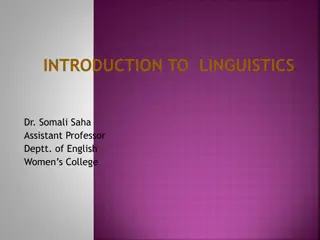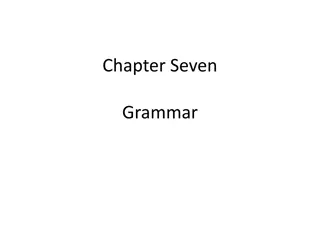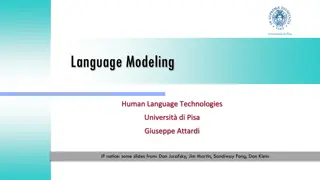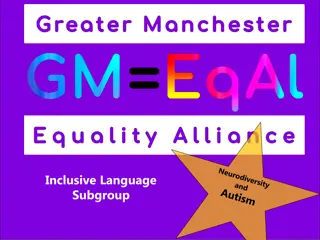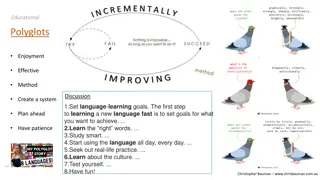Understanding Phonology Concepts in Language Learning
Phonology is the study of sounds in language and how they are produced. This content explores the production of sounds, types of sounds like plosives and fricatives, common phonological errors, and the "fis" phenomenon. It also discusses term deletion, exemplified by omission, substitution, addition, reduplication, and assimilation. Additionally, it touches on football intonation research by Cruttenden in predicting match outcomes.
Download Presentation

Please find below an Image/Link to download the presentation.
The content on the website is provided AS IS for your information and personal use only. It may not be sold, licensed, or shared on other websites without obtaining consent from the author. Download presentation by click this link. If you encounter any issues during the download, it is possible that the publisher has removed the file from their server.
E N D
Presentation Transcript
How are sounds produced? Sounds are produced by air from the lungs passing across the vocal cords. Consonant: a speech sound that is produced when a vocal tract is either blocked or so restricted so that there is audible friction. Vowel: a sound made without closure or audible friction. Dipthong: a vowel in which there is a perceptible change in quality during a syllable. E.g ride (ai), void (oy), or thorn (aw).
Types of sound Examples Plosives or stops are created when the airflow is blocked for a brief time. p, t, k; b, d, g, Fricatives are created when the airflow is only partially blocked and air moves through the mouth in a steady stream. S in sip th in thing Sh in ship th in this Z in zip f in fox S in vision Affricatives are created by putting plosives and fricatives together. J ch Approximants are similar sounds to vowels R w Nasals are produced by air moving through the nose. M N ing as in ring Laterals are created by placing the tongue on the ridge of the teeth and then air moving down the side of the mouth. L http://www.uiowa.edu/~acadtech/phonetics/english/english_main.swf
Common phonological errors: Deletion Substitution Addition Reduplication assimilation
Term Deletion Explanation Omitting the final consonant in words. Substituting one sound for another (especially the harder sounds that develop later e.g. sh or th.) Adding an extra vowel sound to the ends of words, creating a cvcv pattern. Changing one consonant or vowel for another (as in early plosive sounds) Repeating a whole syllable Examples Do instead of dog Substitution Pip instead of ship Addition doggie Assimilation Gog for dog Reduplication Dada, mama Consonant cluster reductions Consonant clusters can be Pider instead of spider difficult to articulate, so children reduce them to smaller units Omitting the opening syllable in polysyllabic words. Deletion of unstressed syllables Nana for banana
Moving Fish Animation Fish animation test The fis phenomenon Berko and Brown (1960s). Discovered that a child who referred to a plastic inflatable fish as a fis , couldn t link to an adult s use of fis with the same object. Child: A fis Child: A fis Adult: is this your fis? Adult: is this your fish? Child: no Child: yes, my fis 1) Why do you think that the child only responded to the adult s correct pronunciation of fish ? What does this suggest about the ability of a child to imitate adult speech? 2)
Football Cruttenden Research point: Cruttenden (1974) found that adults were more accurate in predicting football results from listening to the scores, finding that adults could successfully predict winners by the intonation placed on the first team. Why did Cruttenden use football scores? Why do you think young children are less able to interpret intonation? http://www.youtube.com/watch?v=pD3DCLT HvmI
Phonological acquisition sequence Pamela Grunwell s 1987 Age (Months) 24 30 36 42 48 plus Phonemes p, b, m, d, n, w, t K, g, h, F, s, j, l What is the pattern of types of sounds being produced?
Substituting One Sound for Another Researchers have identified a number of different types of substitutions in toddlers' speech. Toddlers substitute a sound that they have difficulty making with another sound that they can produce. The p, b, t, d, k, and g sounds all develop early. They are known as "stop sounds" because air flowing from the lungs is "stopped" by the front or back of the tongue touching the roof of the mouth or by the lips touching together. In comparison, for f and s which develop later, the tongue must be kept at a certain distance from another spot in the mouth to allow air to flow through. This action requires finer motor control and may be more difficult for toddlers. Stopping occurs when toddlers substitute a stop sound for one where the air should flow through. For example, twenty- four-month-old Max said, "do" for shoe. Stopping occurs most often on the beginning sounds in words. Toddlers may also "stop" nasal sounds as twenty-six-month-old Avery did when she said, "sab" for Sam.
Fronting is another type of substitution. It occurs when toddlers substitute a sound produced at the front of the mouth (e.g., t, d, n, s) for a sound produced at the back of the mouth (e.g., k, g, ng) or middle of the mouth (e.g., sh). For example, toddlers may produce "cat" as "tat" and "show" as "sew." Fronting has been identified in 23% of 36-month-old toddlers. Gliding is a substitution occurring when l or r are replaced with w or y. For example, thirty-month-old Avery said, yick for lickand wock for rock. Gliding may continue into the school years.
Saying the Same Sound in Two Places in a Word is by saying the same sound in place of two different sounds in the same word - assimilation. For example, toddlers commonly produce doggie either as goggie or doddie. Instead of using both a d and a g sound, they use the same consonant twice. Another way that toddlers simplify the words they say Sometimes when words have a sound produced at the back of the mouth (e.g., k, g) at the end of the word, toddlers will also produce a back consonant at the beginning of the word. For example, Max, at 27 months, said, kake for take. He also produced dark as gawk.
Simplifying consonant clusters consonants are produced together (e.g., slip). Toddlers make words easier to say by simplifying consonant clusters. Most frequently, they will delete a consonant from a consonant cluster. Consonant clusters occur when two or three For example, twenty-six-month-old Max said poon for spoon. Toddlers may delete the first consonant (e.g., s in spoon) or the second consonant (e.g., p in spoon) in the consonant cluster. The language that the toddler is learning and each toddler s preferences will affect which consonant is deleted. Toddlers learning English have some predicable patterns of simplifying consonant clusters.
Choose 2 of these phonological errors and write a PEE paragraph Pip for ship Pligget for Piglet Shoulder for soldier ditdit instead of sister Shite instead of fight (!!!) rerind instead of rewind alloon instead of balloon ambliance instead of ambulance Hoptical instead of hospital gagga instead of grandma guay instead of grandpa


